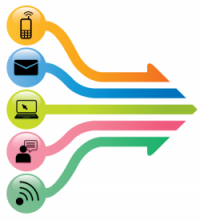Multichannel Selling and Why It Could Be Good for Your Store

While online retailers continue to rely on Google for traffic and revenue, many shoppers no longer use it to begin their search for products.
Instead they start on Amazon, eBay or Overstock, or go to shopping comparison search engines like Shopzilla.com. According to comScore, up to 7 times more people search for products on Amazon than on Google Shopping.
Shocking? Perhaps.
But when you think of our new shopping habits, with 60% of shoppers using tablets and 84% looking for recommendations on social media before buying, it becomes clear that there is a world of opportunity beyond the world’s main search engine.
Enter Multichannel Selling
You may have heard of Multichannel Selling before. Traditionally, the term referred to brick and mortar stores that also sold through catalogues. Today however, it means using a multitude of online channels to reach a customer.
Online retailers now have an abundance of channels at their disposal, many frequented by large numbers of their potential customers. From website, to mobile apps, marketplaces, comparison sites, catalogues, and more, there are many ways to place products in front of your target audience.
But is this something you should consider too?
Let’s have a look.
Why Invest in Multichannel Selling?
#1) Multichannel shopping is becoming a popular option among shoppers. Researchers from Wharton School of University of Pennsylvania discovered that two-thirds of all shoppers regularly use more than single channel to purchase.
#2) It offers an opportunity for additional sales. This one is really a no-brainer, right? Since shoppers use these channels to find the very products you sell, you should be there too.
#3) Selling through many channels gives you the ability to reach customers that wouldn’t otherwise have found your site. Everyday shoppers type in product names in Google. But given the way the search engine works, the chances that they are going to land on your site might be close to none.
Unless you are willing to pay for paid ads of course. But if the same customer types their search into a shopping engine or Amazon, the chances for your product to appear in front of them increase exponentially.
#4) With multiple channels you can take less recognized brands in front of customers. If you sell less recognized brands, Multichannel Selling might help you position them for type and industry related searches.
#5) It helps to build brand loyalty, too. Researchers from aforementioned Wharton School in Pennsylvania also discovered that purchasers who use 3 or more channels are the most likely to come back to the retailer for their next purchase.
But that’s not all. According to both online retailing association Shop.org and the Wharton School of University of Pennsylvania, customers using multi channels to shop differ from those buying from a single channel.
- Multichannel shoppers tend to earn more money.
- They also buy more often. Multichannel shoppers buy on average 12% more often than single channel shoppers.
- They also spend more. Multichannel shoppers, according to Shop.org have a 32% higher annual spending history. According to the Wharton’s School report, their average spend is over $400.
Overall, they seem more valuable to online retailers than single channel shoppers.
What Channels are Out There?
I realize that the term Multichannel Selling might be misleading. After all, just what are these multiple channels that I can use to sell? Here is a list of the most common ones:
- Brick and Mortar Stores. Historically the most obvious place to sell goods. And some ecommerce retailers still maintain traditional stores too.
- Website. The heart and soul of your business.
- Mobile store. With the growth of smartphones and mobile devices, having a mobile store or mobile website is really a must.
- Mobile app. Bigger retailers offer dedicated shopping apps (i.e. Amazon, eBay) making buying from mobile devices a breeze.
- Marketplaces. Retailer now can also sell directly through Amazon, eBay, Overstock, Buy.com, and more.
- Comparison Shopping Engines (CSEs). These are sites like Pricegrabber and Nextag, which list different products and make it easier for customers to find the place to buy them.
- Catalogues. In some industries (cosmetics, for example – just look at what Avon is doing!) catalogues are still a thriving channel to reaching out to customers.
- A Sales force. Some retailers employ sales people to look after corporate customers, for instance, or bring in large, bulk orders.
How to Know if Multichannel Retail is for You?
Given all the benefits of multichannel retail, it might be tempting to try and jump into it right away. But before you begin reading Amazon Marketplace terms & conditions or getting your inventory up on Shopzilla, ask yourself:
“How do my potential customers buy?”
Do they use Google? Or do they go straight to Amazon, eBay etc.? Do they buy through a mobile phone, and if so, how? Through a dedicated app or again, just use the search engine? Or perhaps they prefer to click on product recommendations from their friends on Facebook?
Then make sure that you base your next steps on what your audience wants, not just on what seems like a good idea in the moment.








